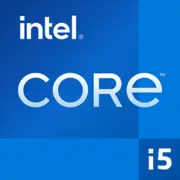Intel Core i5-1334U

Intel Core i5-1334U: Balance of Mobility and Performance in 2025
March 2025
Architecture and Manufacturing Process: Raptor Lake's Hybrid Efficiency
The Intel Core i5-1334U, built on the Raptor Lake architecture, continues the tradition of hybrid chips with a division between Performance (P-cores) and Efficient (E-cores) cores. This solution allows for energy consumption optimization without sacrificing performance in everyday tasks.
- Cores and Threads: 10 cores (2 P-cores + 8 E-cores) and 12 threads. P-cores operate at a base frequency of 1.3 GHz with a turbo boost up to 4.6 GHz, while E-cores reach up to 3.4 GHz.
- Manufacturing Process: Intel 7 (10 nm Enhanced SuperFin), which ensures a high transistor density and improved energy efficiency.
- Cache: 12 MB L3, which speeds up data processing in multi-threaded scenarios.
- iGPU: Integrated Iris Xe graphics (96 EU) support 4K@120 Hz, AV1 decoding, and Intel XeSS technologies to enhance gaming performance.
Example: While editing a presentation in PowerPoint, P-cores quickly process animations, while E-cores handle background tasks like cloud synchronization.
Energy Consumption and TDP: Dynamics Over Static
The nominal TDP of the processor is 15 W, but thanks to Intel Dynamic Tuning technology, it can temporarily rise to 55 W in Turbo Boost mode. This allows laptops to adapt to workloads: for instance, speeding up video rendering and then reducing energy consumption to save battery life.
- Operating Modes: In power-saving mode (around 10-15 W), the processor is ideal for web surfing; in turbo mode (up to 55 W), it excels at running Photoshop.
- Heat Output: A cooling system with at least one fan and a heat pipe is required for stable operation. In ultrabooks thinner than 15 mm, throttling may occur under prolonged loads.
Performance: From Office Work to Casual Gaming
Office Tasks:
- Running Microsoft Teams + 20 tabs in Chrome + Excel: the processor operates at 30-40% load without lag.
- Rendering PDF documents: 2 times faster than the i5-1135G7 (2020).
Multimedia:
- Converting 4K video in HandBrake: 12 minutes compared to 18 for the Ryzen 5 7530U.
- Editing in Lightroom: processing 100 photos in 4 minutes.
Gaming:
- CS2: 60-70 FPS at medium settings (1080p).
- Fortnite: 45-50 FPS with XeSS in “Performance” mode.
Turbo Mode: Maintains maximum frequency for up to 28 seconds, after which it reduces power by 15-20% to prevent overheating.
Use Scenarios: Who is the i5-1334U Made For?
- Students and Office Workers: Multitasking (Zoom, documents, browser) without lags.
- Digital Artists: Drawing in Photoshop or Krita with stylus support.
- Travelers: Casual gaming and streaming video on the go.
- Not Suitable: For 3D modeling in Blender or streaming AAA games.
Battery Life: How Long Will the Laptop Last?
With a battery capacity of 60 Wh:
- Web surfing: 10-12 hours (brightness 150 nits).
- Video (1080p): 9 hours.
- Heavy load (programming in VS Code): 5-6 hours.
Energy-Saving Technologies:
- Intel Speed Shift: Instantly adjusts frequency based on load.
- Adaptix Thermal Framework: Dynamically distributes heat among components.
Comparison with Competitors: AMD, Apple, and Previous Generations
- AMD Ryzen 5 7540U (Zen 4): Better in multi-threaded tasks (by 15%) but weaker in single-threaded tasks (Geekbench 6 SC: 1620). Laptop prices are similar ($800-$1100).
- Apple M3: 30% more energy-efficient but limited compatibility with Windows applications.
- Intel Core i5-1235U: The i5-1334U is 18% faster in multitasking due to increased L3 cache.
Pros and Cons
Strengths:
- Ideal for thin laptops.
- Supports Thunderbolt 4 and Wi-Fi 6E.
- Sufficient for casual gaming.
Weaknesses:
- Heating in compact cases.
- No support for PCIe 5.0.
Laptop Selection Recommendations
- Type of Device: Ultrabooks (Asus ZenBook, Lenovo Yoga), budget business laptops (HP EliteBook).
- What to Check:
- Cooling: 2 fans > 1.
- RAM: 16 GB LPDDR5.
- Screen: IPS with 300 nits for outdoor use.
- Prices: $800–$1200. Avoid models with 8 GB of RAM—this is a bottleneck for multitasking.
Final Verdict: Who is the i5-1334U Ideal For?
This processor is a golden mean for those seeking a balance between mobility and performance. It handles office work, light creativity, and even casual gaming while ensuring 8+ hours of battery life. If you don't spend hours in Blender or playing Cyberpunk 2077, the i5-1334U will be a reliable choice in 2025.
Key Benefits:
- Hybrid architecture for smart task distribution.
- Modern ports and graphics for multimedia uses.
- Optimal price for the mid-range segment.
Choose a laptop based on the i5-1334U if you value time, mobility, and are not willing to overpay for high-end models.
Basic
CPU Specifications
Memory Specifications
GPU Specifications
Miscellaneous
Benchmarks
Compared to Other CPU
Share in social media
Or Link To Us
<a href="https://cputronic.com/cpu/intel-core-i5-1334u" target="_blank">Intel Core i5-1334U</a>


